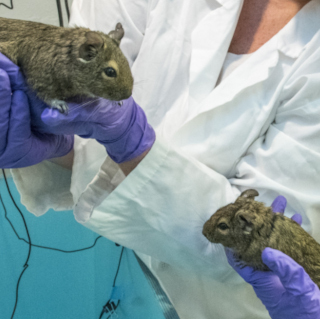SPF Mouse Serology
Last Review Date: September 28, 2020
Purpose
Specific pathogen-free (SPF) mouse sentinel serology is done as part of a comprehensive preventive health care and disease surveillance program.
Responsibility
It is the responsibility of the AV to provide oversight and for the LAR staff to understand, to be proficient in, and to participate in the serology testing program.
Procedure
Examination and Sample Collection
A. On a semiannual basis, collect SPF sentinel mice from each mouse room into clean
microisolator cages.
microisolator cages.
1. All mouse rooms in Skaggs Building (SB), 027, 037, 039, 066, 061B, and Health
Sciences Building (HS) B004 mouse quarantine.
Sciences Building (HS) B004 mouse quarantine.
2. Take one sentinel mouse from every rack and place into a clean cage.
3. Label each box with a new cage card that includes room number, rack
number, and investigator.
number, and investigator.
B. Move mice on a clean cart to HS 016, LAR Clinical Lab
C. Fill out IDXX RADIL serology paperwork (print from computer or get hard copy from
file cabinet).
file cabinet).
1. The order in which the mice are listed on the submission form will be the order
in which animals are necropsied. List smallest room number first and proceed
to larger room numbers.
in which animals are necropsied. List smallest room number first and proceed
to larger room numbers.
D. Pre-label all Opti-spot dried blood spot cards that will hold samples.
E. Items needed
1. Scissors
2. Forceps
3. Peroxigard RTU
4. Microscope slides
5. Sharpie® markers
6. Microscopes (optical and dissecting)
7. Clear cellophane tape
8. Opti-spot dried blood sport card
9. Fecal flotation tubes
10. Sterile scalpel blades
11. 25-gauge needles
12. 1-mL syringes
13. Sharps container
14. Paper towels
F. Place mouse (proper order of serology paperwork) in CO2 chamber and euthanize
using 20% volume displacement per minute inside the chamber.
using 20% volume displacement per minute inside the chamber.
G. Retrieve blood via cardiac puncture.
1. Use a 1 cc syringe with 25 ga needle.
2. Place one large drop (approximately 25 microliters) of blood in the
designated circle of the dried blood spot card.
designated circle of the dried blood spot card.
3. Allow sample to dry for 1 hour before folding protective upper tab over the
blood spot and tuck under the lower tab.
blood spot and tuck under the lower tab.
H. Label tail with the number from serology paperwork using a Sharpie® marker.
I. Use a dissecting microscope to check body for ectoparasites and abnormalities.
J. Collect a fur tape sample and a perianal sample using cellophane tape. Press the
tape firmly against the skin. For perianal samples, place tape over anus and draw a
large circle around the sample area using a Sharpie® marker.
tape firmly against the skin. For perianal samples, place tape over anus and draw a
large circle around the sample area using a Sharpie® marker.
1. Place fur and perianal tapes on separate slides and label.
2. 3 samples of each specific type can fit on a slide.
3. Do not mix fur tapes and perianal tapes on the same slide.
4. Use an optical microscope to check the sample for the presence of pinworm
eggs and other parasites.
eggs and other parasites.
K. Incise the mouse along the ventral midline of the body.
L. Check for abnormalities of internal organs (location, size, texture, color).
M. Collect one fecal pellet from the rectum.
1. Place in pre-labeled fecal flotation tube.
2. 3 samples from different mice may go into one tube, in the order written on
the submission form.
the submission form.
N. Push contents of cecum onto a slide.
1. Label slide with mouse number(s); 3 samples can fit on one slide.
2. Use a dissecting microscope to check the sample for the presence of adult
pinworms
pinworms
O. Double check that all procedures were finished and all necessary samples were
collected before discarding each carcass.
collected before discarding each carcass.
Fecal Flotation
A. Once all necropsies are completed, prepare fecal floats for parasite eggs.
B. There should be a maximum of three fecal samples in one tube.
C. Use a transfer pipet to add a small amount of "Vetus Feca Test solution (a 1:18
dilution of Vetus Feca Test Dry Concentrate" diluted with water) to tube and mixwell
with feces. (This 1:18 solution and concentrate are located in HSB016 metal cabinet).
dilution of Vetus Feca Test Dry Concentrate" diluted with water) to tube and mix
D. Use a transfer pipet to fill the tube to top with Vetus Feca solution, creating a
meniscus.
meniscus.
E. Place square coverslip on top of tube
F. Let stand for 10 minutes.
G. Place the cover slip on a clean slide; create minimum air bubbles.
H. Use compound microscope to examine the samples for eggs of internal parasites.
Packaging Samples for IDEXX RADIL
A. Place Opti-spot samples into a ziplock bag.
B. Place the IDEXX RADIL paperwork together with the ziplock bag of samples into an
appropriately sized shipping envelope for priority mail and seal.
appropriately sized shipping envelope for priority mail and seal.
C. Mail from campus post office.
1. 2-day service (either UPS or USPS, whichever is cheaper).
2. Use IDXX RADIL address listed on paperwork
3. Charge to UM credit card.
